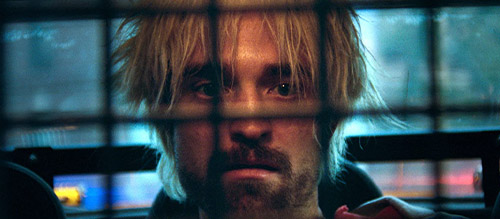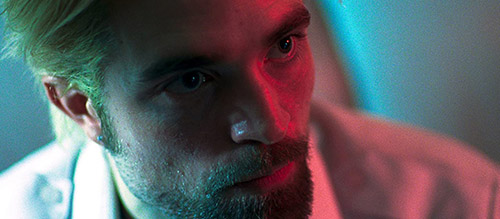Good Time (2017) Review
This article was written exclusively for The Film Magazine by Leoni Horton of Leoni Horton Movies.
Good Time (2017)
Directors: Benny Safdie, Josh Safdie
Screenwriters: Ronald Bronstein, Josh Safdie
Starring: Robert Pattinson, Benny Safdie, Jennifer Jason Leigh, Buddy Duress, Taliah Webster, Barkhad Abdi
The Safdie Brothers’ gritty pulp thriller Good Time invites us to spend a night in the company of one of New York City’s most vivacious scumbags. It’s a film that is a significant step-up in every way for the home-grown, independent filmmaking duo who were once described as New York’s best-kept secret. The brothers, who have been cobbling together movies on their own resources since childhood, have seen their notorious style evolve with each project, gaining praise and popularity along the way. Their harsh depiction of drug-addicted street-kids in Heaven Knows What drew the attention of Twilight megastar Robert Pattinson, who claimed that he intrinsically knew he wanted to work with the brothers after seeing just one still from the movie on Indiewire. Pattinson’s unshakeable allegiance to any project Josh and Benny might send his way once again distracted the duo from their Diamond District movie (Uncut Gems) and set them on course for Good Time.
The brothers’ 2017 release is a relentless barrage of anxiety and violence centred around Connie Nikas (Robert Pattinson), a fast-talking, quick-witted sleaze-bag. He pushes Nick (played by one-half of the filmmaking duo Benny Safdie), his firmly built younger brother with learning disabilities, into a sketchy bank robbery from which Connie escapes but Nick does not. Frantic to free Nick from the infamous Rikers Island, Connie embarks on a rapid-paced odyssey through the underbellies of Manhattan and Queens, desperately trying to put together bail money or find an opportunity that will reunite him with his brother.
Every character Connie meets, however minor, is used for money, information or resources, and he will stop at nothing to get what he wants from them. Connie has the distinct ability to get exactly what he wants from people because lying is effortless for him. We can almost see the gears churning inside his mind as he formulates the next chapter of his plan, the next move which will put him one step closer to his end goal. His journey sees him body snatch a hospital patient he believes to be his brother, shamelessly seduce a sixteen-year-old girl so he can gain access to her phone and hair-dye, and break into an amusement park in the dead of night to search for a bottle of liquid LSD.
Connie is a sordid version of a typical on-screen anti-hero in that he is despicably violent and calculating but also endlessly captivating. It’s the nuance in Pattinson’s performance which gives Connie his many distinctive layers. While Connie is ready to cheat, scheme and physically assault those who stand in his way, he also appears to have respect for others, which we see when people fall into step with his plans. “God bless you”, and “Thank you Ma’am” are phrases he often throws around in appreciation, and which transcend him out of the shoes of a typical lowlife. It’s an act, and it isn’t – it is his undeniable charisma, charm and smooth talk which allows him to navigate the world as he does. As the film unfolds, we realise that, for Connie, it isn’t just about freeing his brother, but that manipulating his way through the world is his compulsion; he is unable to stop or slow down. This animalistic way of living is all he knows, and he has curated a specific personality and behaviour to allow himself to do it.
The most insidious part of Connie’s mission is his tendency to lean into and use America’s racial prejudice for his own benefit and gain. The most shocking moment of the movie comes when Connie beats a black security guard to unconsciousness and steals his uniform, resulting in a police racial profiling incident which is horrifyingly realistic and believable. While Good Time is a depiction of criminal low lives, it also reveals some uncomfortable truths about American police systems and their ugly racial prejudices, which too often makes criminals of victims and innocents. Good Time acknowledges the good and evil which exists on both sides of the law.
Heavily influenced by neorealist cinema, the Safdies often choose to work with non-professional actors and build narratives reflective of the life of the common man. From inside Rikers Island, Buddy Duress was commissioned by Josh Safdie to keep a prison journal and write about the year he had to spend on the run from the police. Duress’ writing influenced much of the plot of Good Time and the character of Ray who he went on to play. While it was no doubt intimidating to go up against a seasoned actor such as Robert Pattinson, Duress steals the show with an erratic yet beautifully delivered monologue in which he outlines the night leading up to the events that put him in the hospital. Duress’ distinctively rugged face and sharp Queen’s motor-mouth gives us a taste of the alternative world existing under New York City’s polished surface.
Sean Price William’s camerawork is essential to Good Time’s storytelling, as it’s reflective of the urgency and psychological disarray of our leading protagonists. His decision to shoot on 35mm with a widescreen aspect ratio gives the footage a grainy and mottled texture whilst also providing an unsettling, naturalistic aesthetic. His intrusive close-ups in cluttered and tight locations lend the film its feeling of confinement and oppression, and his surrealist neon colour palette aids the outlandish personalities and events we must contend with on screen. William’s vivid light alongside Danial Lopatin’s pulsating techno-grunge score only relents when Connie is off-screen. When we see Nick alone in his therapy groups, the lighting is standard and the music calm, suggestive of the normality Nick can have in life when he is away from his deplorable older brother.
Although Good Time has more narrative momentum than any of the Safdies’ previous features, they maintain their improvisational approach through character. As Connie’s night spirals out of control, his distinct ability to improvise and adapt to any situation takes over. This feeling of impromptu decision making comes from years of experience on behalf of The Safdies, who have filmed on the streets of New York without permits, and who often work with whatever vibrant concoction of people, equipment and material that becomes available to them. The Safdies’ ability to create tense, anxiety-inducing cinema has not wavered, Good Time is as heart-racing and authentic as any of their previous features. Without using guns and weapons, the Safdies have created a cops and robbers run-around with a sense of distinct danger, which speaks to their impressive ability to create recognisable genre movies without falling back on any of the tired or overused tropes many filmmakers have become reliant upon.
It won’t have escaped your attention that this story revolves around the relationship of two brothers. The connection between Connie and Nick is easily forgettable in the mix of the relentless action and insistent scheming. However, when we are given a brief pause to reflect on the momentum that drives these characters far enough to break the law and push themselves beyond their capabilities for one another, we arrive at the conundrum of love. Love makes us do crazy things and can take us to places we never thought we might go. Although it is hidden, the film’s driving force is the love and connection that exists between brothers. Blink and you might miss it, but under the surface there exists latent sentiment from Josh and Benny, who have often described themselves as partners in crime.
22/24
Written by Leoni Horton
You can support Leoni in the following places:
Twitter: @inoelshikari
Blog: Leoni Horton Movies



